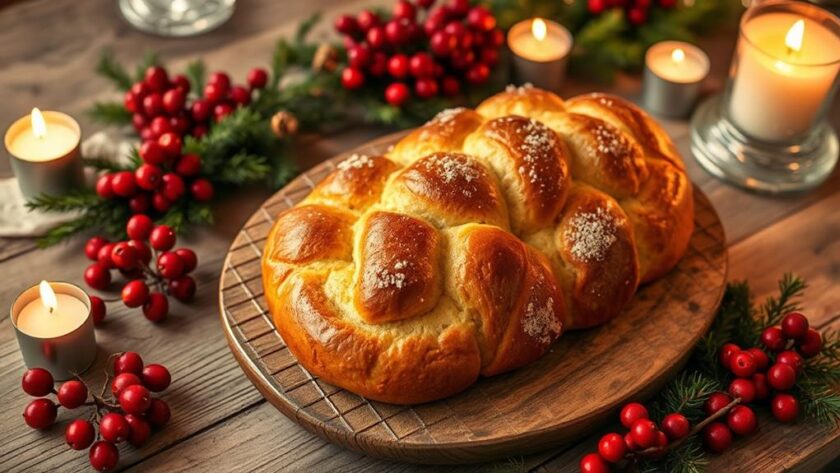Swedish Christmas bread, known as Vörtbröd, offers a warm taste of tradition for your holiday spread. With flavors of malt wort, cardamom, and quark cheese, it's perfect for gatherings. You can enhance it with dried fruits and nuts for a festive touch. Baked traditionally on December 22nd, this bread symbolizes togetherness during the holidays. The unique blend of spices creates a rich aroma that fills your home with warmth and cheer. To make the most of this delightful recipe, there's more to explore about the baking process, serving suggestions, and cultural significance that will enhance your holiday celebrations.
The Magic of Swedish Christmas Bread
The enchanting aroma of Swedish Christmas Bread, or Vörtbröd, fills the air during the festive season, inviting you to experience its rich flavors. This traditional treat is more than just a loaf of bread; it's a celebration of Swedish heritage.
As you take part in the baking process, you'll find that the unique flavor profile comes from the perfect blend of malt wort, spices like cardamom, and the creamy texture of quark cheese. Traditionally, this bread often incorporates dried fruits and nuts, enhancing its festive spirit and connection to cultural traditions, similar to Julekage Bread's significance.
While baking Vörtbröd may seem challenging, the rewards are well worth the effort. The sense of nostalgia it brings connects you to generations of Swedish families who've shared this festive delight.
Imagine slicing into a freshly baked loaf on December 22nd, the day when many start their holiday preparations.
Vörtbröd shines as a versatile addition to your holiday spread, pairing beautifully with cheese or a creamy beetroot salad.
Whether you're enjoying it at a festive gathering or savoring it alone, each bite transports you to a cozy Swedish kitchen filled with love and tradition.
Embrace the magic of Swedish Christmas Bread this holiday season and create memories that will last a lifetime.
Key Ingredients for Success
Creating the perfect Swedish Christmas Bread, or Vörtbröd, hinges on selecting the right ingredients. Start with a good yeast mixture, as it's vital for leavening. This guarantees your bread rises properly and achieves that light, airy texture everyone loves.
For an added layer of flavor, consider soaking your raisins in dark rum, similar to the process in traditional Norwegian Julekake recipe, which enhances their sweetness and richness. You'll also need standard components like flour and salt, but the magic truly lies in the special additions.
Wort is essential for sweetness, giving your bread that traditional sweet flavor. Quark adds creaminess, contributing to a delightful mouthfeel.
Don't forget the blend of spices—ginger, dried cloves, aniseed, fennel, and cardamom—which infuses your Vörtbröd with warmth and festive cheer. For a unique twist, incorporate pomeran peel, derived from the bitter citrus fruit, to add a complex flavor that sets your bread apart.
Lastly, consider tossing in some raisins or almonds. These additions not only enhance the flavor but also allow you to personalize this beloved recipe.
Step-by-Step Baking Process
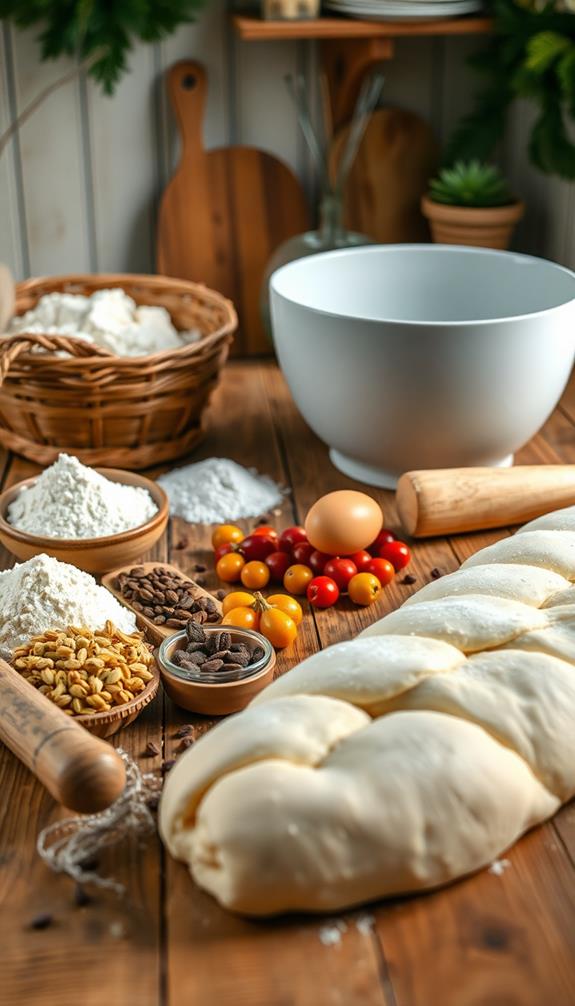
To kick off your baking journey, start by preparing a yeast mixture with 1/4 cup warm water, 4.5 teaspoons of active dry yeast, and a pinch of sugar. Let it activate for about 5-10 minutes.
In a separate bowl, mix 1/2 cup melted butter, 1 cup whole milk, 1 teaspoon salt, 1 teaspoon cardamom, and 2 eggs. This will create a rich base for your Swedish bread, reminiscent of the traditional flavors found in Authentic Norwegian Julekake Recipe.
Once the yeast is bubbly, combine it with the milk mixture. Gradually add 2 cups of all-purpose flour, then continue adding an additional 2.5 cups until a smooth, elastic dough forms. Knead the dough for 3-5 minutes.
Place the dough in a warm spot, cover it, and let it rise for about 1.5 hours, or until it doubles in size.
After it's risen, shape the dough and allow it to rise again for 30-45 minutes.
Traditional Serving Suggestions
While enjoying Swedish Christmas bread, or Vörtbröd, you'll find that it pairs wonderfully with creamy beetroot salad or a selection of cheeses, enhancing its rich flavors during festive meals.
This traditional Scandinavian Christmas bread, often enriched with candied fruits and warming spices, adds a delightful sweetness to your holiday spread, making it a perfect addition for family gatherings. Traditionally served warm from the oven, its sweet and spiced aromas create a warm, inviting atmosphere for your holiday season gatherings.
To elevate your experience, try spreading cardamom butter on a slice of Vörtbröd for a deliciously indulgent treat, perfect for Christmas breakfasts or brunches. This traditional serving suggestion not only complements the bread but also adds a delightful twist to your holiday spread.
You can also create a festive platter by including dried fruits and nuts alongside the freshly baked Vörtbröd. This not only offers a variety of textures and tastes but also reinforces the spirit of togetherness, as family and friends gather to share in the joy of the season.
For an enhanced flavor experience, consider soaking raisins in rum or boiling water before folding them into the dough, which is a key ingredient of traditional Julekage that can elevate your festive baking.
Make your holiday meals memorable by incorporating these traditional serving suggestions, ensuring that Vörtbröd becomes a cherished centerpiece during your celebrations. Enjoy the warmth and flavors that this beloved bread brings to your festive table!
Cultural Significance of Vetebröd
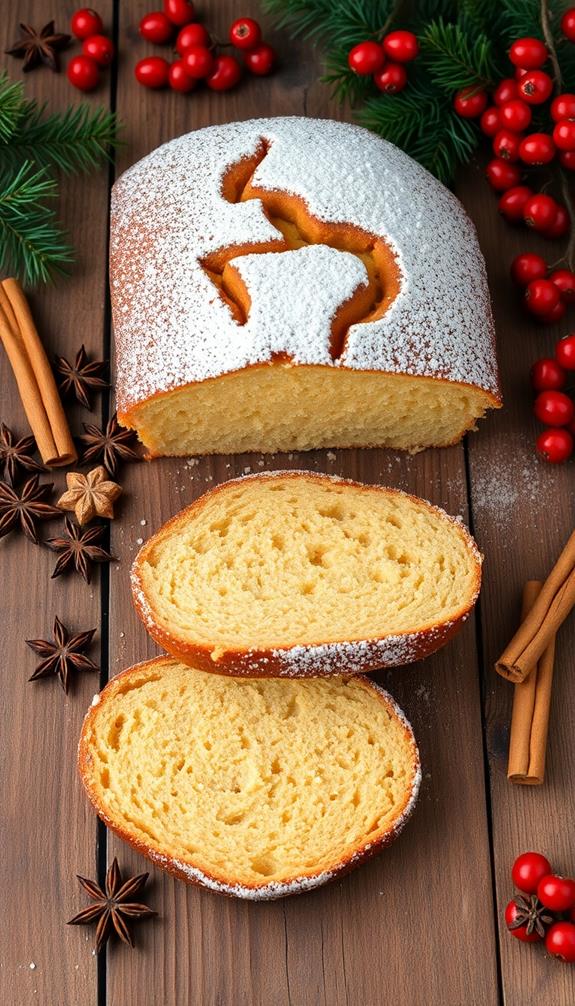
Vetebröd is more than just a delicious sweet yeast bread; it embodies the spirit of Swedish holiday traditions. This beloved treat, often flavored with cardamom, evokes memories of family gatherings during Christmas, reinforcing connections through shared culinary heritage.
In fact, the preparation of Vetebröd often includes techniques reminiscent of making a classic Swedish Princess Cake, emphasizing the importance of quality ingredients and craftsmanship. You'll find that Vetebröd is typically baked for festive occasions, serving as a reminder of the importance of family recipes that have been passed down through generations.
Known affectionately as "bulle," or bun, Vetebröd features distinctive flavors, possibly including raisins, almonds, or spices like cinnamon. The preparation isn't just about baking; it involves traditional techniques such as kneading the dough until smooth and allowing it to rise, showcasing the craftsmanship inherent in Swedish baking.
As you gather around the holiday table, Vetebröd transforms into more than a treat; it becomes a festive centerpiece, symbolizing warmth and connection among loved ones.
During Christmas, this bread serves as a delicious reminder of shared traditions and the joy of coming together. So next time you enjoy a slice of Vetebröd, appreciate not just its taste, but the rich cultural significance it holds for Swedish families during the holiday season.
Variations and Creative Twists
As you explore the world of Swedish Christmas bread, you'll discover a variety of exciting adaptations that allow for personal expression in baking. One way to put your twist on this festive treat is by experimenting with different spices. Consider adding cinnamon, raisins, or almonds to create unique flavor profiles.
You can also try using whole wheat or rye flour for a deeper character that sets your bread apart. Additionally, incorporating the use of evaporated milk can enhance the richness of your dough, similar to how it brings depth to traditional kringle recipes.
Don't forget about presentation! Braiding the dough or shaping it into a festive wreath can elevate its visual appeal, making it a stunning centerpiece for your holiday table.
Another delightful variation involves drizzling a sweet glaze made from powdered sugar and vanilla extract over the baked bread. This not only adds a decorative touch but also enhances the overall flavor.
Feel free to incorporate local ingredients or seasonal produce like dried fruits or nuts, which can reflect your regional influences and personal tastes. These variations not only honor tradition but also allow you to make the Swedish Christmas bread your own, ensuring that each slice tells a story of creativity and holiday spirit.
Common Baking Challenges
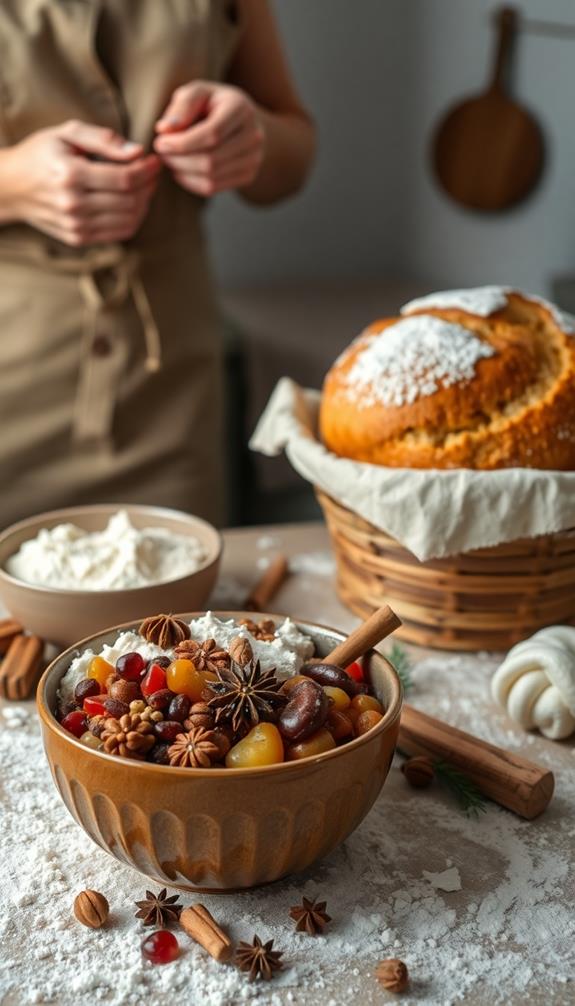
Baking Swedish Christmas bread can come with its fair share of challenges. You might struggle to find specific ingredients like wort, and nailing the right measurements and timing is essential for perfecting your dough.
The process of recreating traditional recipes often brings a sense of nostalgia, as these baked goods evoke memories of family gatherings and celebrations. Mastering the handling techniques can make all the difference in achieving that traditional texture and flavor, capturing the joy found in nostalgic desserts.
Ingredient Sourcing Difficulties
Sourcing the right ingredients for Swedish Christmas bread can feel like a quest, especially when you're after unique items like wort and quark. These ingredients aren't just hard to find; they often require a dedicated trip to specialty stores or online retailers. Outside of Sweden, wort's specialized nature makes it a rare find in mainstream grocery stores, leaving you to search diligently or rely on substitutes that may alter the bread's traditional flavor.
Quark, a key ingredient for creaminess, presents its own challenges. If you can't locate it, you might resort to other cheeses or homemade alternatives, which can impact the texture and taste of your final product.
Then there are the specialty spices—dried cloves, aniseed, fennel, and cardamom—vital for authentic flavor. These mightn't be available at your local market, and using improper substitutes can lead to flavor imbalances.
Navigating these ingredient sourcing difficulties is essential for achieving that perfect loaf. With a bit of perseverance and creativity, you can gather what you need to create a delicious and traditional Swedish Christmas bread that captures the spirit of the season.
Measuring and Timing Precision
Achieving the perfect Swedish Christmas bread hinges on precise measuring and timing. When measuring your ingredients, especially cups of flour, it's imperative to use a kitchen scale for accuracy. Even slight variations can lead to over-risen or dense loaves, which won't deliver that beloved texture.
For spices like cardamom and cinnamon, measuring accurately is just as important; you want to achieve a balanced flavor profile without overwhelming the bread.
Timing plays a significant role too. Allow your dough to rise until it doubles in size, which typically takes about 1.5 hours. Don't rush this process; it's crucial for developing the right texture.
When it comes to baking, stick to the recommended time of 25-30 minutes at 350°F for ideal results.
Keep an eye on your dough's elasticity by performing the windowpane test. This helps you know if you've kneaded it enough and prevents under-proofing.
With careful attention to measuring and timing precision, you'll set yourself up for success and create a delicious loaf that embodies the spirit of Swedish Christmas traditions. Happy baking!
Dough Handling Techniques
When you handle your dough with care, you'll set the foundation for a successful Swedish Christmas bread. Start by kneading the dough for 3-5 minutes until it's smooth and elastic. This step is essential for achieving that perfect texture.
Once kneaded, cover the dough and let it rise in a warm environment for about 1.5 hours, or until it doubles in size. This fermentation process is important for flavor development.
When it's time to roll out the dough, aim for a rectangular shape. This helps with even filling and shaping, which is crucial for the final presentation.
After shaping, give the dough a second rise of 30-45 minutes in a warm spot. This step enhances the bread's flavor and texture.
Watch out for common challenges like under-proofing, which can result in dense bread, or over-kneading, leading to a tough texture. Keep an eye on your dough's consistency throughout the process.
Using active dry yeast properly can help mitigate these issues. With careful dough handling, you'll be on your way to creating a delightful holiday treat that captures the essence of tradition.
Flavor Profile and Aroma
There's something enchanting about the flavor profile of Swedish Christmas bread, or Vörtbröd, that captures the essence of the holiday season. The distinctive blend of sweetness and spice makes each bite a celebration of flavors.
You'll notice the prominent notes of cardamom, ginger, and aniseed, which infuse the bread with that warm, festive taste. The addition of wort, a sweet malt infusion, elevates the bread's sweetness, giving it a unique depth that sets it apart from other holiday offerings. This exquisite flavor experience is somewhat reminiscent of the almond extract infused oatmeal cookies, where the nutty undertones create a sophisticated dessert option.
The flavor profile is beautifully balanced by the inclusion of pomeran peel, which adds a subtle bitterness that enriches the overall taste experience.
As the bread bakes, the aroma wafts through your home, inviting and nostalgic, reminiscent of cherished holiday gatherings. The scent of warm spices and sweet malt creates an atmosphere that's hard to resist.
When you serve Vörtbröd fresh, you can enhance its flavor even further with a spread of cardamom butter or a drizzle of vanilla glaze. This not only accentuates the sweetness but also makes it a delightful addition to your holiday spread, ensuring your seasonal celebrations are truly memorable.
Tips for Perfecting Your Bread
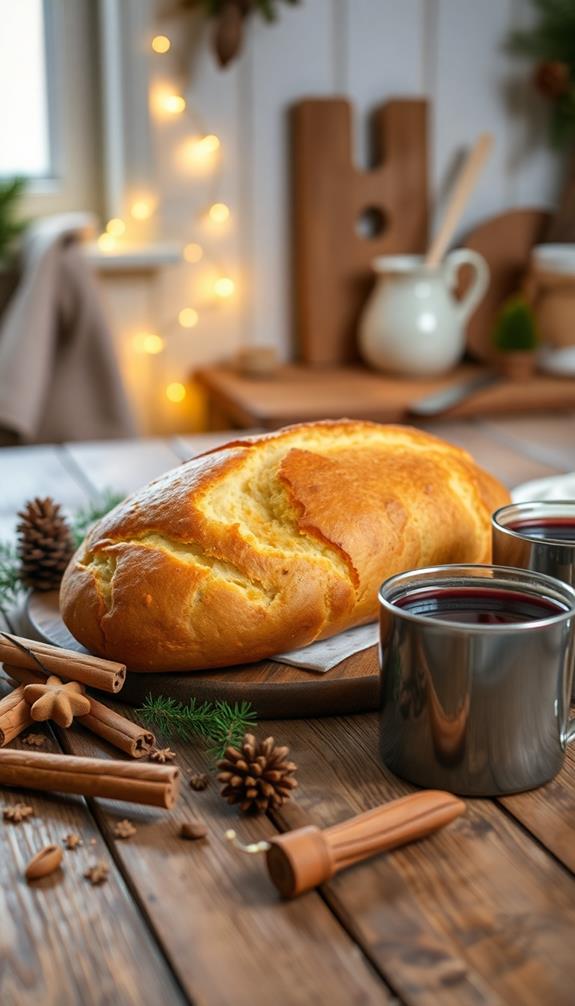
To create the perfect Vörtbröd, paying attention to detail in your baking process is key. Start by ensuring precise measurements of your ingredients, especially when balancing spices like cardamom and cinnamon. This balance is vital for achieving that authentic flavor profile characteristic of Swedish Christmas bread.
Knead the dough for 3-5 minutes until it's smooth and elastic. This step is essential for developing the right texture and ensuring a proper rise during fermentation. Let the dough rise for 1.5 hours until it doubles in size.
After shaping, give it a second rise for 30-45 minutes to enhance fluffiness.
When you're ready to bake, preheat your oven to 350°F. Keep a close eye on the baking time, typically between 25-30 minutes, to avoid over-browning while ensuring the interior is thoroughly cooked.
Sharing the Holiday Spirit
Celebrating the holiday season with Swedish Christmas Bread, or Vörtbröd, offers a delightful way to share warmth and joy with family and friends. This beloved bread is more than just a treat; it symbolizes togetherness and the spirit of remembrance.
As you gather around the table, you might reserve a place for your deceased loved ones, honoring their memory while creating new traditions.
The aroma of baking Vörtbröd fills your home, evoking nostalgia and inviting shared experiences among family members. When you engage in festive baking, you not only strengthen familial bonds but also share your unique variations of this cherished recipe. Each loaf carries the stories of generations, connecting you to your cultural identity.
Sharing baked goods like Vörtbröd during your holiday gatherings fosters a community spirit. It encourages everyone to contribute their own recipes and memories, enriching the festive atmosphere.
As you pass around slices of this warm, spiced bread, you're not just sharing food; you're sharing love and joy, creating lasting connections with your loved ones. Embrace the holiday spirit and let Vörtbröd be the centerpiece of your celebrations, bringing everyone together in delightful unity.
Conclusion
Swedish Christmas bread, or vetebröd, brings warmth and tradition to your holiday celebrations. Did you know that nearly 80% of Swedes enjoy this festive treat during the Christmas season? By mastering its unique flavors and baking techniques, you can create a delightful centerpiece for your holiday spread. Embrace the cultural significance of this cherished bread, and share its rich history with loved ones, enriching your holiday spirit and creating lasting memories together.

